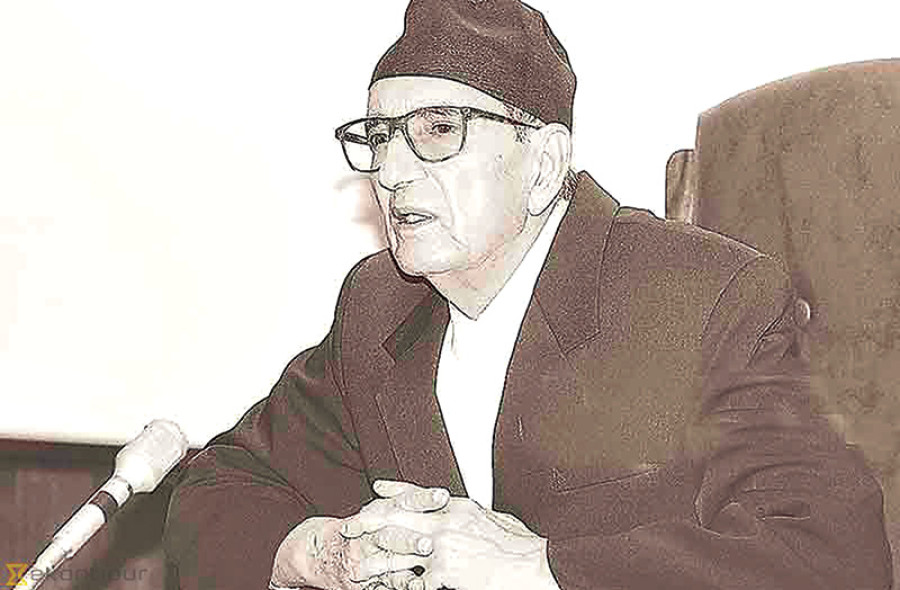Opinion
Fearless leader
This year marks the eighth death anniversary of Girija Prasad Koirala, former prime minister and president of the Nepali Congress (NC). GP was born in 1924 in Tedi of Saharsha district in Bihar state in India where his father, Krishna Prasad Koirala, was living in exile.
Suresh C. Chalise
This year marks the eighth death anniversary of Girija Prasad Koirala, former prime minister and president of the Nepali Congress (NC). GP was born in 1924 in Tedi of Saharsha district in Bihar state in India where his father, Krishna Prasad Koirala, was living in exile. GP followed in the footsteps of his father and elder brothers and joined the Indian independence movement and the struggle against the Rana oligarchy in Nepal. In 1947, GP shot into prominence by organising a strike at Biratnagar Jute Mill in southern Nepal. He also led the establishment of the Nepal Majdoor Congress in 1948 which later became the Nepal Trade Union Congress. In essence, he was a pioneer of the labour movement in Nepal.
After the Rana regime was overthrown, GP became the president of the NC in Morang district in 1952. He held that position until he was incarcerated by the king following the 1960 royal coup. He remained in jail till 1967. After his release, he went to India, and in 1975, became the general secretary of the NC in exile. GP returned to Nepal in 1979 after the king announced a referendum to decide whether to retain the Panchayat system or reinstate the multiparty system. After the death of his brother BP Koirala in 1982, he became one of the NC triumvirate. He was elected NC president and held that position from 1996 to 2010. GP served the country as Prime Minister (PM) four times: 1991-94, 1998-99, 2000-01 and 2006-08.
Open market promoter
GP created an enabling environment for democratic and economic institutions to take root. He pursued a market economy policy and helped integrate Nepal’s economy into the global financial system. GP paid special attention to the development of infrastructure as well as social sectors such as education, health, roads and communication. For all these initiatives, scholars recognise him as the architect of the liberal economy in Nepal, just as PV Narasimha Rao and Deng Xiaoping are credited for the economic liberalisation of India and China respectively.
When the king attempted to implement direct rule on February 1, 2005, GP led a seven-party alliance and spearheaded People’s Movement II. During his political campaign, octogenarian leader GP reassured the people by saying, “This is the last movement for democracy. After this movement, no one will have to struggle for democracy again.” The political stir, which was supported by the Maoists in accordance with the 12-point agreement, galvanised the political environment in favour of the reinstatement of the dissolved Parliament. The restored Parliament on April 24, 2006 not only led the extrication of the country from the clutches of the king’s authoritarian rule but also the restoration of multiparty democracy in the Himalayan country.
Globally recognised
After the success of the People’s Movement, GP went on a state visit to India as the Nepali PM and was accorded a warm welcome by Indian prime minister Manmohan Singh. While receiving GP at New Delhi airport, the Indian prime minister recognised Koirala’s struggle for democracy and his standing in the region. Singh remarked, “You are the greatest leader in South Asia, we respect you and we are proud of you!”
GP, in cooperation with other forward looking forces, engaged the Maoists who had been waging their People’s War since 1996 through a 12-point agreement. This accord paved the way for the success of the People’s Movement in April 2006. Subsequently, a seven-party government was formed under Koirala’s leadership which signed the historic Comprehensive Peace Agreement (CPA) in November 2006, ending the decade-long conflict that had caused more than 13,000 deaths apart from the displacement of hundreds of thousands of people within country.
It was a defining moment for Koirala when his deeds were recognised by a personality none other than former US president Jimmy Carter. On June 14, 2007, while addressing mediapersons in the prime minister’s official residence at Baluwatar, he said, “GP Koirala is my hero.” GP is not among us, but the major task of the peace process has been accomplished. The Maoist rebels have been managed and mainstreamed into the democratic polity. A new constitution has been promulgated by the Constituent Assembly, and, of late, the country has entered into a federal structure after holding elections to the federal, provincial and local governments.
However, new challenges too have cropped up. The NC, South Asia’s grand democratic force which had once been gloriously led by GP himself, faced a humiliating defeat in the recently held elections owing to poor management and organisational mess. Victory and defeat are natural outcomes in an election, but an electoral fiasco befell a credible democratic force while a young and unseasoned left alliance secured a two-thirds majority. This has induced a curious and conspicuous diplomatic courtship in the current politically charged regional atmosphere.
Chalise is a former ambassador of Nepal to the United States and United Kingdom




 9.12°C Kathmandu
9.12°C Kathmandu









%20(1).jpg&w=300&height=200)

